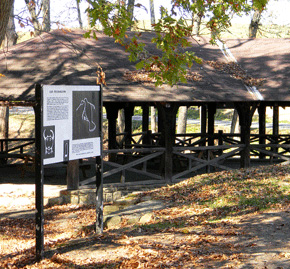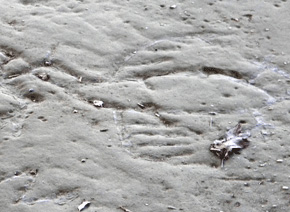ATHENS, HOCKING VALLEY
LEO PETROGLYPHS

A timber structure built by the WPA in the 1930’s shelters both a picnic area and the petroglyphs.
Leave Chillicothe via US 35 through the villages of Richmond Dale and Savageville, then turn left for about 4 miles to the village of Leo. The road to the site (signposted) heads northwest for about a half-mile. On an exposed dome of sandstone, surrounded by a walkway, the centuries-old petroglyphs (rock-writings) are inscribed.
There are 37 figures of birds, fish, feet, hands, and human and composite creatures, visible as the diffused daylight washes across the surface. Their subtlety is revealed, as one visitor has suggested, by staring for a few moments until they begin to show, like the stars at night.
Most likely they had a meaning when taken together, rather than being hieroglyphs standing for individual words. Archaeologist Brad Lepper:
I think there’s a story there to be read, but the key, we don’t have the key anymore, so I don’t think we can read it now. But there are elements like the human face with the antlers, I think in many rock art traditions in America, that seems to reflect spiritual power. So it may not be a photographic representation of a creature with antlers, but it may just represent a Shaman, a Medicine Man or Woman, and the antlers are an indication of the spiritual power that that person had. So there are aspects of it that I think we can tease out, but… I think the meaning of the entirety of it is lost to us.
From the weathering of the rock and the nature of the symbols, experts think the petroglyphs are less than a thousand years old, probably done in the “Fort Ancient” era, or by historic Indians. Living among these hills, probably in villages, they would have been drawn to the nearby Scioto Salt Licks in Jackson, and the Zaleski Flint deposits to the north in what is now Vinton County.
At one point recently the recessed lines were traced in dark material to make them more visible, though that is mostly faded now. The park is called the Leo Petroglyphs State Memorial, and the inscribed outcrop stands at the edge of a beautiful ravine. Trails explore both in and around the 60-foot sandstone cliffs. There is a small bridge, and abundant birds and wildflowers.
In 1780, the Moravian missionary David Zeisberger observed that the Indians along the Muskingum River often recorded their stories with paint on forest trees. He wrote:
If a party of Indians have spent a night in the woods, it may be easily known... by their marks on the trees, to what tribe they belong. For they always leave a mark behind made either with red pigment or charcoal. Such marks are understood by the Indians who know how to read their meaning. Some markings point out the places where a company of Indians have been hunting, showing the number of nights they spent there, the number of deer, bears and other game killed during the hunt. The warriors sometimes paint their own deeds and adventures, the number of prisoners or scalps taken, the number of troops they commanded and how many fell in battle... These drawings in red by the warriors may be legible for fifty years…
The Leo Petroglyphs are the closest thing we have indicating how such inscriptions may have been part of a visual language with specific meanings, although those meanings now elude us.

The human face with antlers probably represents a leader with spiritual powers.


